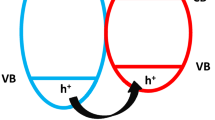Abstract
Photocatalytic degradation is an advanced process which utilizes light for degradation of organic pollutants. In this study, we have investigated the photocatalytic properties of reduced siloxene nanosheets for the removal of dyes from wastewater. Reduction of siloxene resulted in a decreased bandgap from 2.7 to 2.3 eV, allowing for better absorption of visible light, and quenched photoluminescence, indicating increased efficiency in the utilization of the absorbed light energy for photocatalytic reactions. The catalytic activity of the reduced siloxene nanosheets followed a pseudo-second-order model and exhibited an adsorption capacity of 9.6 mg/g for Methylene Blue Dye (MB). Our results demonstrate that reduced siloxene nanosheets have significant potential as an efficient and effective catalyst for removing organic pollutants from wastewater. The reduction induced changes in the bandgap and photoluminescence quenching contributed to enhanced increase in catalytic activity (78%) as compared to the siloxene (53%).
Graphical abstract




Similar content being viewed by others
Data availability
All data associated with this manuscript are included within the main text and the supplementary information accompanying this publication.
References
V. Batra, I. Kaur, D. Pathania, Sonu, V. Chaudhary, Efficient dye degradation strategies using green synthesized ZnO-based nanoplatforms: a review. Appl. Surf. Sci. Adv. (2022). https://doi.org/10.1016/j.apsadv.2022.100314
R.N. Araujo, α-Fe2O3 fibers: an efficient photocatalyst for dye degradation under visible light. J. Alloy. Compd. (2021). https://doi.org/10.1016/j.jallcom.2021.160683
T.M.S. Dawoud, V. Pavitra, P. Ahmad, A. Syed, G. Nagaraju, Photocatalytic degradation of an organic dye using Ag doped ZrO2 nanoparticles: milk powder facilitated eco-friendly synthesis. J. King Saud Univ.—Sci. 32(3), 1872–1878 (2020). https://doi.org/10.1016/j.jksus.2020.01.040
A. Molkenova, S. Sarsenov, S. Atabaev, L. Khamkhash, T.S. Atabaev, Hierarchically-structured hollow CuO microparticles for efficient photo-degradation of a model pollutant dye under the solar light illumination. Environ. Nanotechnol. Monit. Manag. (2021). https://doi.org/10.1016/j.enmm.2021.100507
M. Li, R. Ramachandran, T. Sakthivel, F. Wang, Z.X. Xu, Siloxene: An advanced metal-free catalyst for efficient photocatalytic reduction of aqueous Cr(VI) under visible light. Chem. Eng. J. 421(P1), 129728 (2021). https://doi.org/10.1016/j.cej.2021.129728
W. Wang et al., An overview on nitride and nitrogen-doped photocatalysts for energy and environmental applications. Compos. Part B Eng. 172, 704–723 (2019). https://doi.org/10.1016/j.compositesb.2019.05.097
C. Rosso, G. Filippini, A. Criado, M. Melchionna, P. Fornasiero, M. Prato, Metal-free photocatalysis: two-dimensional nanomaterial connection toward advanced organic synthesis. ACS Nano 15(3), 3621–3630 (2021). https://doi.org/10.1021/acsnano.1c00627
N. Deepak, A. Pandey, S. Shukla, S. Saxena, Siloxene: a novel 2D photocatalyst for degradation of dye molecules. Nano-Struct. Nano-Objects 26, 100721 (2021). https://doi.org/10.1016/j.nanoso.2021.100721
R.A. Rakkesh, D. Durgalakshmi, S. Balakumar, Efficient sunlight-driven photocatalytic activity of chemically bonded GNS-TiO2 and GNS-ZnO heterostructures. J. Mater. Chem. C 2(33), 6827–6834 (2014). https://doi.org/10.1039/c4tc01195c
K. Krishnamoorthy, P. Pazhamalai, S.-J. Kim, Two-dimensional siloxene nanosheets: novel high-performance supercapacitor electrode materials. Energy Environ. Sci. 11(6), 1595–1602 (2018). https://doi.org/10.1039/C8EE00160J
P. Pazhamalai, K. Krishnamoorthy, S. Sahoo, V.K. Mariappan, S.J. Kim, Understanding the thermal treatment effect of two-dimensional siloxene sheets and the origin of superior electrochemical energy storage performances. ACS Appl. Mater. Interfaces 11(1), 624–633 (2019). https://doi.org/10.1021/acsami.8b15323
Q. Meng et al., Siloxene-reduced graphene oxide composite hydrogel for supercapacitors. Chem. Eng. J. 393, 124684 (2020). https://doi.org/10.1016/j.cej.2020.124684
P. Deák, M. Rosenbauer, M. Stutzmann, J. Weber, M.S. Brandt, Siloxene: chemical quantum confinement due to oxygen in a silicon matrix. Phys. Rev. Lett. 69(17), 2531–2534 (1992). https://doi.org/10.1103/PhysRevLett.69.2531
H.D. Fuchs et al., Porous silicon and siloxene: vibrational and structural properties. Phys. Rev. B 48(11), 8172–8189 (1993). https://doi.org/10.1103/PhysRevB.48.8172
M. Stutzmann, M.S. Brandt, M. Rosenbauer, J. Weber, H.D. Fuchs, Photoluminescence excitation spectroscopy of porous silicon and siloxene. Phys. Rev. B 47(8), 4806–4809 (1993). https://doi.org/10.1103/PhysRevB.47.4806
E. Evgenidou, K. Fytianos, I. Poulios, Semiconductor-sensitized photodegradation of dichlorvos in water using TiO2 and ZnO as catalysts. Appl. Catal. B Environ. 59(1–2), 81–89 (2005). https://doi.org/10.1016/j.apcatb.2005.01.005
Acknowledgments
The authors express their gratitude for the financial support received from the Department of Science and Technology, Ministry of Science and Technology, Technology Mission Division, India, through grant no. DST/TM/WTI/WIC/2K17/100(C). Additionally, this study was supported by the Science and Engineering Research Board (SERB), India, under grant no. EMR/2017/005144.
Funding
Not applicable.
Author information
Authors and Affiliations
Contributions
Nav Deepak: conceptualization, experimentation, data analysis and writing original draft. Sumit Saxena: supervising the project, editing manuscript. Shobha Shukla: manuscript editing
.
Corresponding author
Ethics declarations
Conflict of interest
The authors declare no known competing financial interests or personal relationships that could appear to influence the work reported in this paper.
Additional information
Publisher's Note
Springer Nature remains neutral with regard to jurisdictional claims in published maps and institutional affiliations.
Supplementary Information
Below is the link to the electronic supplementary material.
Rights and permissions
Springer Nature or its licensor (e.g. a society or other partner) holds exclusive rights to this article under a publishing agreement with the author(s) or other rightsholder(s); author self-archiving of the accepted manuscript version of this article is solely governed by the terms of such publishing agreement and applicable law.
About this article
Cite this article
Deepak, N., Shukla, S. & Saxena, S. Two-dimensional reduced siloxene metal-free semiconductor for enhanced photocatalytic performance. MRS Advances (2024). https://doi.org/10.1557/s43580-024-00870-9
Received:
Accepted:
Published:
DOI: https://doi.org/10.1557/s43580-024-00870-9




